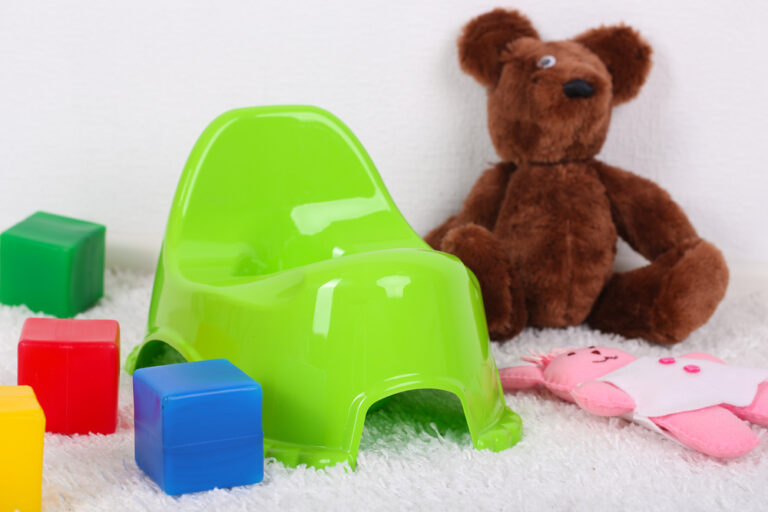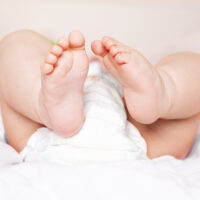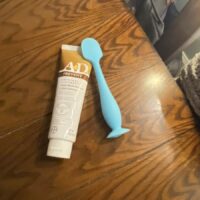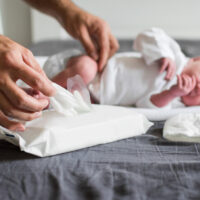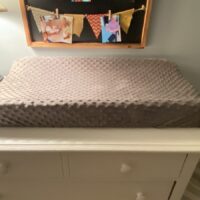I used diapers with my two oldest children but experienced quite a few issues. Most of the issues were normal problems all parents deal with, blowouts, leaks, and diaper rashes. However, the diaper rashed did not get better even when switching to different brands of diapers multiple times.
Diaper Issues With My First Two
At the time, we were military stationed in Germany with limited American options for diapering on base. The German diapers were much nicer to my babies’ bottoms but when my second child was eight-months-old, we moved back to the States. The severe diaper rashes came back.
With my middle child, the rashes were so bad I had to blow dry her little tushy at every diaper change, which was every hour to help with the rash. Applying cornstarch, which I preferred over most diaper rash creams, to prevent moisture helped more than anything else.
If only I had known babies could be allergic to diapers. The thought never crossed my mind. Not once did I think to switch to cloth diapers. Shipping stuff over from American stores wasn’t as much of an option for military on base back then.
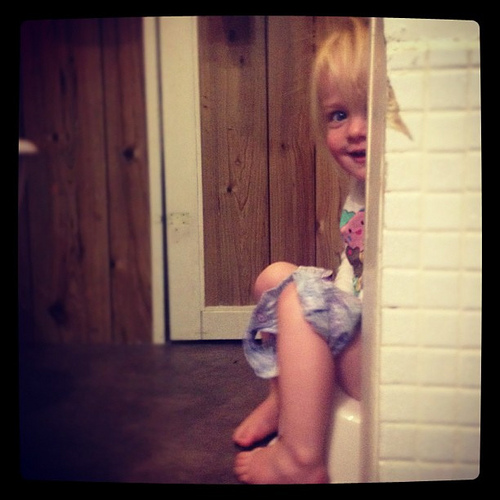
Baby Number Three on the Way
Fast forward to when my other two children were six and four-years-old. Our family was stationed in Germany for a second time and baby number three was on the way. Hoping to avoid severe diaper rashes, I did some serious research for coping with rashes and which diapers caused the least issues.
My other two were already potty trained and now I was about to begin the diapering process again wondering if this baby would experience the same rashes as the first two children. Also, my other two had issues switching from using diapers to a potty because, at two and a half to three, the potty was a foreign object and method of relieving one’s self. While scouring the internet, I found an article that hit home for me.
Diapers weren’t the sole option for taking care of babies bathroom needs. Who knew?
Elimination Communication
An article on Elimination Communication broadened my limited knowledge of diapering options. The term elimination communication refers to training infants to use the potty from birth instead of using diapers. The process includes paying attention to your baby’s cues as a form of communication for when your baby needs to pee or poo.
Most babies provide body or facial cue to let mom know when the need to eliminate. Most mothers notice their babies squirming, grunting, or turning tomato red from exertion when pooping. Mom’s who potty train look for these type of squirmings and then rush the baby to the potty. Once the baby is on the potty, you make a “shssssssss” sound to help the baby understand now is the time to relieve themselves.
Families who practice EC experience earlier success potty training a baby, often before the age of two. This new method of potty training excited me for two reasons. First, fewer diapers meant less diaper rash. Second, using the potty from birth meant my baby would always know what the potty was for and it would never be a scary foreign object.
Mind you, my goal was never to use just EC but to use EC in conjunction with diapers. The thought of doing EC alone was too daunting for public excursions. Definitely a foreign concept to me, my husband and all of my skeptical friends. Despite the strangeness of the concept, I was intrigued.
Starting the Potty Process
I waited until my baby was a month old to begin EC because I was so tired with three children at home and the baby, Alex, never stopped crying from colic. During that first month, I paid attention to her cues and noticed her body language when she was about to fill her diaper.
I stocked up on the necessary tools, including flushable wipes and toddler potties of which Germany had an excellent selection, and began potty training a month after Alex was born. Before starting I also stocked up on cloth diapers for home use and the best disposable diapers – both German and American diapers – for use outside the house.
I did not sign up to rush a baby through a German store with pee dripping from her clothes as I searched for a bathroom. Nope. Disposables were very useful. We used them out of the house and when the baby was sick and at night. As I said, my goal was never to use EC exclusively but to use it as a tool.
The cloth diapers were great because Alex could feel the wetness and helped her to build self-awareness about her potty needs. We kept toddler potties around the house and put her on the potty as often as was feasible. These little potties meant I didn’t need to run her to the bathroom each time too.
Let The Potty Training Begin
The process was exhausting! I misread clues and ran her to the toilet or toddler potty around forty times a day at first! Alex rewarded my attempts. I put her on the potty and made the “shsssssss” sound. Voila! Alex more often than not went potty. Those moments felt like parenting wins! I praised Alex ever time.
I would inevitably miss the next cue and she would soak a diaper which I would have to wash. Yeah, washing diapers took a large chunk of my time and German wash machines are inferior to American machines.
By six months though, my daughter only dirtied four diapers a day. Then my husband deployed for six months when Alex was eight-months-old. Six long months in a different country far away from my family.
Two Steps Forward and Three Steps Back
Alex did not like daddy disappearing and potty training fell to the back burner. I managed to get her back on track with some success. Alex bonded with daddy before he left while on the potty with books and smiles. He came home to an un-trained fourteen-months-old.
When daddy returned, all was great. One night, at twenty-months-old, Alex saw me snacking on chocolate. Naturally, she wanted some too. In her cute baby voice, she asked, “Mama, I coco?” I told her she could have some chocolate if she used the potty. She gave me a quizzical look and then a light bulb turned on above her head.
After toddling over to the potty she left a little present before coming back and asking for coco again. With her success rewarded, a couple of minutes later she went back to the potty for round two. Success!
Don’t get too excited though because a couple of months later my husband deployed again. More setbacks ensued as all the progress disappeared when daddy left. The kids and I spent the summer in California with my brother while my husband was deployed.
Alex surrounded by tons of children using the potty decided to give up her pull-ups and use the potty exclusively. Nighttime accidents continued for a while longer as she was a hard sleeper. But the journey to potty training was done at just over two-years-old. I didn’t even start trying to potty train the other kids until they were two and a half!
Potty Goals
Alex may have been trained a whole lot earlier than two if I was more consistent with elimination communication. I did accomplish the main goal though to provide her with awareness of her body’s need to eliminate. Her older siblings did not gain this awareness until they were somewhere much closer to three-years-old.
The mindset no for America is potty training toddlers. Other countries use different methods. Germany, for instance, prefers diapers but potty trains before two so their children can go to preschool which was reserved for potty-trained children. China and Africa do not use diapers near as much as America and train their babies with variations of EC. Neither way is right or wrong but a preference each family needs to decide on for themselves.
What I Learned
Here is what I learned during my journey of part-time potty training a baby under two years old:
- Running a baby to the potty is very annoying in outfits that snap shut between their legs.
- Holding your baby on the potty gives you a lot of one-on-one time to bond.
- Babies dislike big changes at home – like daddy leaving. They will notice and they will have setbacks.
- Disposable diapers hinder potty training because they absorb the liquid and the accompanying discomfort. Cloth diapers work much better during potty training.
- Either way, you go, you are training your baby and you still have to clean up pee and poop. You either train them to go in their diaper or in the potty.
- Cleaning up baby messes off the floor is incredibly annoying but no more annoying than cleaning up a blowout.
- Night training with EC means less sleep but the baby wakes up when the urge hits and this is the mindset you will want when they are older.
- Toddlers have to change their complete mindset. Parents train them to go in their pants and at two or three and then tell them to switch to the potty.
- Making the shssssssss noise trains a baby to understand the concept of peeing at specific times. Babies can, in fact, hold their bladder but not for long. The noise helps babies to become self-aware.
- Babies who learn the shssssssss noise will learn to make that noise when they need to pee, which is a great help to mamas.
- A lot of babies dislike diapers or sitting in their pee or poop.
- Potty training from birth does not put expectations on the baby but on the parents just at different stages.
Would I Try Elimination Communication Again?
If I traveled back in time I would not try EC on my oldest. He never cared if he was wet. He didn’t care about getting out of diapers until we found a tiny urinal and he saw everyone in his preschool class using the potty. My middle child, she would have taken to the training as she always hated being wet and the ensuing diaper rashes.
I would try elimination communication with Alex again and hopefully learn from my mistakes. Each child is different and will have different successes. Either way, I hope my trials and errors help you to make a more informed decision for your family even if only to let you know of other potty options besides diapering alone.
